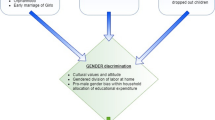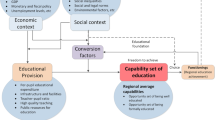Abstract
Despite an extensive system of public schools, Abbottabad, Pakistan has a chronically low literacy rate. A factor contributing to these low literacy rates might be a spatial mismatch between public schools and dense settlements in fast-growing urban and semi-urban areas of this municipal region. To test this proposition, the locations of 153 public schools were collected using hand-held GPS devices to create a geo-database, and a road network was created from the open street map and Google imagery. Nearest neighbor, K-function, Spearman’s Rho, and directional analyses were applied to this data to overcome limitations of sparse geo-spatial data. A point pattern analysis shows that more than 50% of secondary schools were clustered south of the city while most of the built-up area was in the north. Localizing Geo-spatial data, spatial restructuring, and reorganization of schools in the study area would support rational planning and enhance student access to school facilities.









Similar content being viewed by others
References
Al-Enazi, M., Mesbah, S., & Anwar, A. (2016). Schools distribution planning using GIS in Jeddah city. International Journal of Computer Applications, 0975–8887, 138(1), 33–36.
Amemiya, E. C. (1964). Economic differentiation and social organization of standard metropolitan areas. Journal of Regional Science, 5(2), 57–61.
Awad-Gladewitz, D. D. (2014). Education sector development programme in Pakistan’s Khyber Pakhtunkhwa province. Afghanistan/Pakistan: Deutsche Gesellschaft für Internationale Zusammenarbeit (GIZ). Retrieved from, https://www.giz.de/expertise/downloads/giz2014-enfaltblatt-19-pakistan.pdf.
Bailey, T. C., & Gatrell, A. C. (1995). Interactive spatial data analysis. London: Longman Scientific & Technical.
Bennett, R. J. (1979). Spatial time series. London: Pion.
Boots, B. N., & Getis, A. (1988). Point pattern analysis. Beverly Hills: Sage University.
Carnoy, M., Loyalka, P., & Androuschak, G. (2012). “Does expanding higher education equalize income distribution?” The case of the BRIC countries (pp. 1–44). Working Paper, Center for Education Policy Analysis.
Diggle, P. J. (1983). Statistical analysis of spatial point patterns. Cambridge, MA: Academic Press.
Getis, A., & Ord, J. K. (1992). The analysis of spatial association by use of distance statistics. Geographical Analysis, 24(23), 190–206.
Gylfason, T., & Zoega, G. (2003). Education social equality and economic growth: A view of the landscape. CESifo Economic Studies, 49(4), 557–579.
Jong, T., & Ritsema, J. R. (1999). Accessibility analysis and spatial competition effects in the context of GIS-supported service location planning. Computers, Environment and Urban Systems, 23(2), 75–89.
Kiskowski, M. A., Hancock, J. F., & Kenworthy, A. K. (2009). On the use of Ripley’s K-function and its derivatives to analyze domain size. Biophysical Journal, 97(4), 1095–1103.
Li, D., Gong, J. A., & Yue, P. (2014). Geoinformatics education in China. Geospatial Information Science, 17(4), 208–218.
Lucas, R. E. (1988). On the mechanics of economic development. Journal of Monetary Economics, 22(1), 3–42.
Møller, J., & Waagepetersen, R. P. (2003). An introduction to simulation-based inference for spatial point processes. In J. Møller (Ed.), Spatial statistics and computational methods (Vol. 173)., Lecture Notes in Statistics New York, NY: Springer.
Munir, F., Mehmood, N., & Zeb, A. (2015). Impact of redistribution on income inequality and economic growth in Pakistan. Issues, 3(2), 33–42.
Musakwa, W. (2017). Perspectives on geospatial information technology usage in municipalities and geographic information systems (GIS) education amongst urban planners in Southern Africa. Geospatial Information Science, 20(2), 201–208.
Qazi, W., Raza, S. A., & Jawaid, S. T. (2014). Higher education and growth performance of Pakistan: Evidence from multivariate framework. Quality & Quantity, 48(3), 1651–1665.
Ripley, B. D. (1976). The second-order analysis of stationary point processes. Journal of Applied Probability, 13(2), 255–266.
Ripley, B. D. (1977). Modeling spatial patterns. Journal of the Royal Statistical Society, Series B, 39(2), 172–212.
Ripley, B. D. (1979). Tests of ‘randomness’ for spatial point patterns. Journal of the Royal Statistical Society, Series B, 41(3), 368–374.
Ripley, B. D. (1981). Spatial statistics. Hoboken: Wiley.
Scott, G., & Rajabifard, A. (2017). Sustainable development and geospatial information: A strategic framework for integrating a global policy agenda into national geospatial capabilities. Geo-Spatial Information Science, 20(2), 59–76.
Shahbaz, M., Islam, F., & Aamir, N. (2012). Is devaluation contractionary? Empirical evidence for Pakistan. Economic Change and Restructuring, 45(4), 299–316.
Smith, R. C., & Cheeseman, P. (1986). On the representation and estimation of spatial uncertainty. The International Journal of Robotics Research, 5(4), 56–68. https://doi.org/10.1177/027836498600500404.
Sumari, N. S., Shao, Z., & Kira, E. (2017). Challenges and opportunities for the advancement of GIS education in Tanzania. Journal of Education and Practice, 8(28), 67–75.
Sumari, N. S., Shao, Z., Van Genderen, L. J., Musakwa, M., Ujoh, F., Washaya, P., et al. (2019). Status of geoinformatics education and training in Sub-Saharan Africa: Initiatives taken and challenges. Journal of Geography in Higher Education. https://doi.org/10.1080/03098265.2019.1599831.
Wiegand, T., & Moloney, K. A. (2004). Rings, circles, and null-models for point pattern analysis in ecology. Oikos, 104(2), 209–229. https://doi.org/10.1111/j.0030-1299.2004.12497.x.
Wong, D. W. (1998). Measuring multiethnic spatial segregation. Urban Geography, 19(1), 77–87.
Author information
Authors and Affiliations
Corresponding author
Additional information
Publisher's Note
Springer Nature remains neutral with regard to jurisdictional claims in published maps and institutional affiliations.
Rights and permissions
About this article
Cite this article
Tanveer, H., Balz, T., Sumari, N.S. et al. Pattern analysis of substandard and inadequate distribution of educational resources in urban–rural areas of Abbottabad, Pakistan. GeoJournal 85, 1397–1409 (2020). https://doi.org/10.1007/s10708-019-10029-x
Published:
Issue Date:
DOI: https://doi.org/10.1007/s10708-019-10029-x




